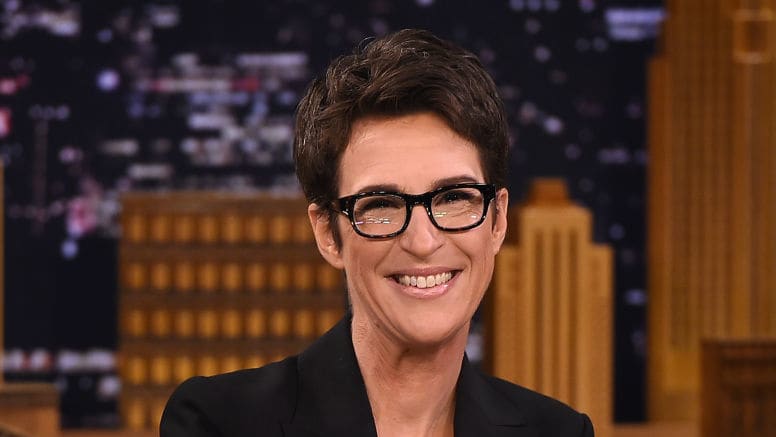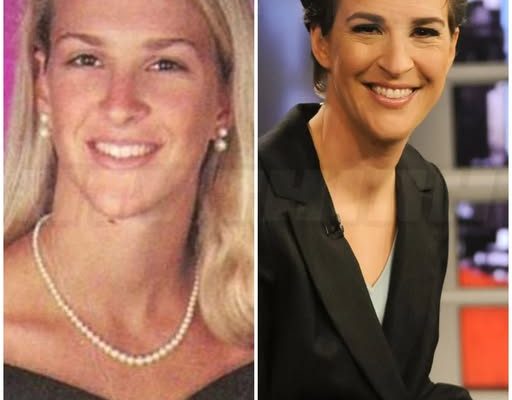💥The life of Rachel Maddow: Find out how a Rhodes scholar and AIDS activist became America’s most unlikely cable television host.
How a Rhodes scholar and AIDS activist became America’s most unlikely cable television host.

Rachel Maddow might be the most unlikely cable television host in the country.
Combining humor, empathy, and some serious research, Rachel Maddow was the first of a new kind of less angry political television host. She’s also the first openly gay host.
Maddow is known for being extremely intelligent — she earned a Rhodes Scholarship to Oxford, and it’s obvious in her lengthy, well-researched monologues that she opens her show with every day. She’s also more civil than some of her peers. She’s chided Pat Buchanan for telling another commentator to “shut up,” and she refuses to act as a referee while guests fight, unlike on her competitor’s shows.
Maddow did not come straight to journalism. Friends thought she’d be a professor or an activist. But after deciding that she liked explaining things to people on a local radio station, it was only a matter of time. She went from that radio station to a bigger radio station, to television, to the face of MSNBC.
As Ben Wallace-Wells put it for Rolling Stone: “What Maddow is trying to build is a different channel for liberal anger, an outsider’s channel, one that steers the viewer’s attention away from the theater of politics and toward the exercise of power, which is to say toward policy.”
Here’s her life so far.
Rachel Maddow was born on April 1, 1973.

She grew up in a centrist house in Castro Valley, east of San Francisco — Maddow later described it as a “middle-class, suburban upbringing.” Both her parents, Bob and Elaine, were Democrats, but they voted for President Ronald Reagan.
Maddow has no memory of reading children’s books, instead she inhaled local newspapers and her dad’s law school texts.
She went to Castro Valley High School.
In high school, she was athletic. She was particularly good at swimming, basketball, and volleyball. But when she injured her shoulder in her final year, she had to decide whether to carry on as an athlete, which meant getting surgery and delaying college, or to push on. She pushed on.
In 1990, when she was 17, she enrolled at Stanford University to study public policy.

Roger Noll, Stanford’s director of public policy at the time, said Maddow was the sort of brilliant student who appeared only every few years. Her professor Debra Satz often showed her students Maddow’s undergraduate thesis on changing perceptions of AIDS.
Early on as a freshman, Maddow came out in an open letter she stuck up in bathroom stalls in her dormitory. She said she wrote the letter so that anyone who was homophobic would have a chance to be open about how they felt, and she could face any hostility head on.
The university’s newspaper, The Stanford Daily, published a story about it and described her as was one of two openly gay freshmen. When a reporter later asked whether the other person was her girlfriend, she said, “Funnily enough, only one other person was out, and she was not one of the many girls I was sleeping with.”
As Jill McDonough, a college friend of Maddow’s, told Rolling Stone: “No one at Stanford was saying they were gay — there were no other out lesbians — and she saw that it was a lie. The choice was, ‘I’m not going to be a hypocrite. I’m going to have courage.’”
A clipping of that article was mailed to her parents, which was how they found out she was gay. They didn’t take it well right away.
For a year after college, she worked as a prison AIDS activist with Act Up and the AIDS Legal Referral Panel in San Francisco.
“We were taking this overwhelming, maddening, depressing, very sad thing that my community and my city were going through and figuring out what pieces of it we could bite off and fix, finding winnable fights in something that felt like a morass and was terrible,” she told The New Yorker.
For years she would continue working with AIDS groups and studying how people perceived and dealt with it.
In 1995, Maddow moved to Oxford as a Rhodes scholar — she was the first openly gay women to do so. She studied AIDS in prisons for her doctorate.
She was also on a Marshall Scholarship, for “intellectually distinguished young Americans” likely to be future leaders.
Despite her scholarships and undergraduate success, she felt out of place and put her studies on hold. She moved to London and worked for an organization called AIDS Treatment Project.
After several stops, she ended up finishing her doctorate, on AIDS health care outcomes in prisons, in western Massachusetts. She told The Nation she wanted to live somewhere where’d she be unhappy.
“And I have no interest in New England, hate winter, don’t like the country, not fond of animals,” she said.
Maddow was friends with Cory Booker at Stanford and Oxford.

Booker, now a New Jersey senator, said that while he was surprised she went the way she did, she was always about making a contribution.
“She wasn’t just about giving commentary; she was an activist,” he told New York Magazine in 2008. “She wanted to change the world.”
After getting her Ph.D., she continued working as an activist. But to pay the bills, because she wasn’t “a trust-fund kid,” she delivered packages, did yard work, and cleaned out buckets at a coffee-bean factory.
When Maddow worked with AIDS advocacy organizations, she wasn’t particularly interested in politics, but she did donate to Harvey Gantt’s campaign for North Carolina’s Senate.
His opponent, Jesse Helms, vehemently opposed funding AIDS research because of his views on homosexuality, according to The New York Times.
She does vote now, at the voting booths in Massachusettes. But it’s not a lengthy process. She registers for a party right before primaries and unregisters right after.
Maddow had a life-changing year in 1999. She started dating the artist Susan Mikula …
The couple met in Massachusetts, while Maddow was still finishing her thesis. Mikula was looking for someone to clean her yard, and Maddow applied.
It was love at first sight. “Bluebirds and comets and stars. It was absolutely a hundred percent clear,” Maddow told The New Yorker.
It helped that Mikula had her initials in metal leaf on her jeep’s door — which Maddow, a fan of kitsch, told New York magazine was very hot.
Their first date was at “Ladies Day on the Range” hosted by the National Rifle Association. They went because they both like shooting, though Mikula is the only one with the hand-eye coordination for it, Maddow told Rolling Stone.
Maddow told The Nation that their relationship was her “proudest accomplishment.”
… and her first break as a host came when she entered a local radio’s open audition to be a sidekick on a show called “Dave in the Morning.”

The radio station held auditions for a morning news announcer, and she got it.
Dave Brinnel, the show’s host, said she had a beautiful voice.
Maddow told Rolling Stone that though she stumbled into the job, it “really clicked.” She liked explaining things to people.
It helped that she was also allowed to play her favorite music, Radiohead and Lucero.
In 2004, Maddow landed a job cohosting a program on Air America called “Unfiltered,” with Chuck D and Lizz Winstead.
While the new radio station hoped to profit from well-known names, it was those with radio experience, like Maddow, who thrived. It was on the radio that she established herself as a “smiling but obstinate liberal.”
In 2005, she started hosting her own show three-hour show.
In 2006, while she was still working for Air America, she started becoming a guest political commentator on CNN and MSNBC, appearing alongside Tucker Carlson, Larry King, and Paula Zahn.
She was a guest on cable news for about three years, described by The Nation as a “ballsy gremlin of the left.”
It was her appearances on Carlson’s show that made her want to be a host. She wanted the ability to choose what was discussed.
“Story selection is half the battle and more than half the fun,” she told Rolling Stone.
She was invited on Fox News only once, when Madonna and Britney Spears kissed.
In January 2008, she became a political analyst at MSNBC.
She was brought on as a left-wing commentator — but she told The New Yorker that though she’s a liberal, she doesn’t have strong feelings against the Republican Party. She’s interested in the sociology of the political styles, especially the “arcane” style of conservatives.
In 2008, “The Rachel Maddow Show” was launched.
It was a milestone. She’s the first openly gay woman to host prime-time news in the US. In her first month, she beat Larry King in ratings, which was unheard of for MSNBC.
Maddow was a different type of news host. She did things like wear pajamas on her show to show solidarity with bloggers.
And the actual show is shot differently from other talk shows. Typically, Maddow sits to the side, whereas other cable shows tend to focus on the face of the host. Other hosts focus on their own personality, while Maddow is about creating a narrative outside of her.
As Rolling Stone’s Benjamin Wallace-Wells wrote: “Bill O’Reilly, on Fox News, is a combatant and a champion. Maddow is a guide. O’Reilly’s show says, ‘Look at me.’ Maddow’s says, ‘Picture this.’”
When Maddow’s show began, MSNBC’s president, Phil Griffin, said his channel had more “swagger” than it had ever had, because of Maddow.
“And trust me. The other guys see it. They are watching. And they are scared,” he told New York magazine.
On the Sunday night before her first show, at a party thrown for the staff, she told the group who had been working on “Verdict with Dan Abrams” and would now be working with her to forget everything they had ever learned.
Maddow didn’t like the gimmicky show that had preceded hers and wanted to be nothing like it, according to Rolling Stone.
But the staffers’ reaction wasn’t great, and she realized right away that she had not worded her speech very well.
At “The Rachel Maddow Show,” her workday typically begins at 12:30 p.m.

Before work, she goes to the gym, fishes, or spends time with Mikula. Her show airs at 9 p.m., and she doesn’t start writing until 4:30 or even 6:30.
She has said she tried writing in the morning, but it didn’t work for her.
“It’s not that I have anything so important going on in my life that I wouldn’t trade it to be better at my job, but it’s that you can only have your brain lit up for that long before it starts to break down and you stop making sense and stop being creative. What I don’t want to give up is the originality,” she told The New Yorker.
She’s called herself the “hermit of Rockefeller Center,” because unlike her host colleagues she’s not networking, she’s too busy writing or meeting with her team to work out what will be in their news agenda.
Maddow is known for her lengthy and in-depth opening monologues.
They go on for a long time, up to 24 minutes, without interruption. She makes sure not to repeat stories that have already been in the news cycle, so that what viewers get is something else. And that’s important, because as Amanda Hess wrote for The New York Times Magazine, her viewers are already familiar with the news cycle. What they want from her is someone to take all of the facts and create a cohesive explanation about what is going on in the world.
In regards, to how she does this, The New Yorker’s Janet Malcolm wrote,”By reducing the story to its mythic fundamentals, Maddow creates the illusion of completeness that novels and short stories create. We feel that this is the story as we listen to and watch her tell it,”
Maddow also marks up the teleprompter with notes about when and how to physically act, like whether to laugh, frown, smile, move her hands, or pause for a moment.
Maddow researches vintage cocktails and makes them for herself and Mikula.
She doesn’t like mingling with politicians and attends only the afterparty for the annual White House Correspondents’ Dinner, not the actual dinner, as long as she’s allowed to be the bartender.
To relax, she also likes to fish and watch films on her laptop. Her favorite film is the original “Manchurian Candidate.”
In 2012, she published her book “Drift: The Unmooring of American Military Power,” which was on The New York Times’ bestseller list.

Maddow’s book is about the United States at war and how it’s changed.
The New York Times said the book, published by Crown, was a reminder that Maddow was a Rhodes scholar, but it also is filled with Maddow’s “cheerfully snarky voice.”
It’s not a piece of left-wing writing either — one of the book’s blurbs was written by Roger Ailes, the former chief of Fox News, who said the book was worth reading. “People who like Rachel will love the book,” he wrote. “People who don’t will get angry, but aggressive debate is good for America.”
Of the writing itself, she told New York magazine: “Writing makes me want to blow my head off. I was very open with Crown about that. They assured me it wouldn’t happen.”
In 2012, Maddow clashed with the Republican strategist Alex Castellanos over whether women earn less than men.
Castellanos said that women didn’t make any less than men and kept interrupting Maddow. He finished by telling Maddow he loved how passionate she was.
“I wish you were as right about what you’re saying as you are passionate about it. I really do,” he said.
Maddow told him that he was being condescending and clarified that her passion was based in fact.
It was instances like these that her producer Bill Wolff thought was what Maddow’s fans liked. He told Rolling Stone that they liked to see her defending rights: “voting rights, reproductive rights, women’s rights, really any kind of rights.”
In December 2015, Maddow focused in on the water crisis in Flint, Michigan, while other national media outlets paid it little attention.

The watchdog organization Media Matters said Maddow had distinguished herself for her show’s in-depth coverage of the Flint water crisis, adding it looked into the issue more than all the other major television networks combined.
In January 2016, she hosted a live town hall in Flint about the crisis.
In 2016, Maddow and Chuck Todd hosted a Democratic debate between Bernie Sanders and Hilary Clinton.
Maddow and Todd were praised for letting the candidates do most of the talking, though they did step in to ask pointed questions.
Some people, like Fox News’ Howard Kurtz, said that the hug was a step too far and that her left-wing views should have disqualified her from being a debate moderator.
But others, including Fox’s Greta Van Susteren, said it was fine — that a hug was a gesture not unlike a handshake.
Regardless, the hugs didn’t do long-term damage to Maddow, and she took the criticism in stride.
During the 2016 presidential election, MSNBC centered its coverage on Maddow and the “NBC Nightly News” anchor Brian Williams.
Hannity refers to her as “Roswell Rachel Maddow.” he has also called her a conspiracy theorist, “tin foil hat Maddow,” and “the single biggest liar.”
According to The New York Times, Maddow’s fans are the “MSNBC Mom” who have been radicalized by the election enough to begin consuming a lot more news.
Deciding how they should cover Trump wasn’t simple for Maddow and her news team. After some thought, they decided they would focus on what the White House did, not what it said. This means Trump is barely ever quoted on her show, instead, Maddow summarizes for him.
In 2017, Maddow homed in on the possibility that President Donald Trump had collaborated with Russia.
From February 20 to March 31, 2017, she covered Russia more than any other single news item, according to The Intercept. During the six weeks, 53% of her broadcasts were about Russia.
With the intense focus on Russia, Maddow had less time to talk about other issues arising from the Trump administration.
In March 2017, Maddow was criticized for a disappointing show about Trump’s tax returns.

To build anticipation, Maddow had tweeted hours before her show that she had Trump’s tax returns. MSNBC put a countdown on for her show.
But instead of demonstrating that he hadn’t paid his taxes, as many people had expected, she showed that he had paid taxes on over $150 million of income in 2005.
Many were disappointed, and the show was criticized on the late-night comedy shows. But over 4 million people watched the episode, her biggest audience ever.
In late 2018, Maddow thrived as she explained the documents released by Robert Mueller, the special counsel leading the Russia investigation.
According to The Washington Post’s media commentator Erik Wemple, Maddow “devoured” the documents, explaining to her audience what was in them, what it meant, and what was missing.
Maddow has said that part of her is on television every night, but not all of her.
“The rest of me is my own,” she told The New Yorker. “It’s not for everybody else. You sort of pick a slice of your life that you’re going to share as your non-TV persona and you give that to people — and they find it more or less interesting.”
In 2019, One America News Network sued Maddow for $10 million after she called it “paid Russian propaganda.”
On her show, Maddow spoke about how an employee of One America News also worked for the news agency Sputnik, which has ties to the Russia government.
“The most obsequiously pro-Trump right-wing news outlet in America really literally is paid Russian propaganda,” she said.
The network claimed that Maddow knew what she said wasn’t true and that it was “as American as apple pie.”



